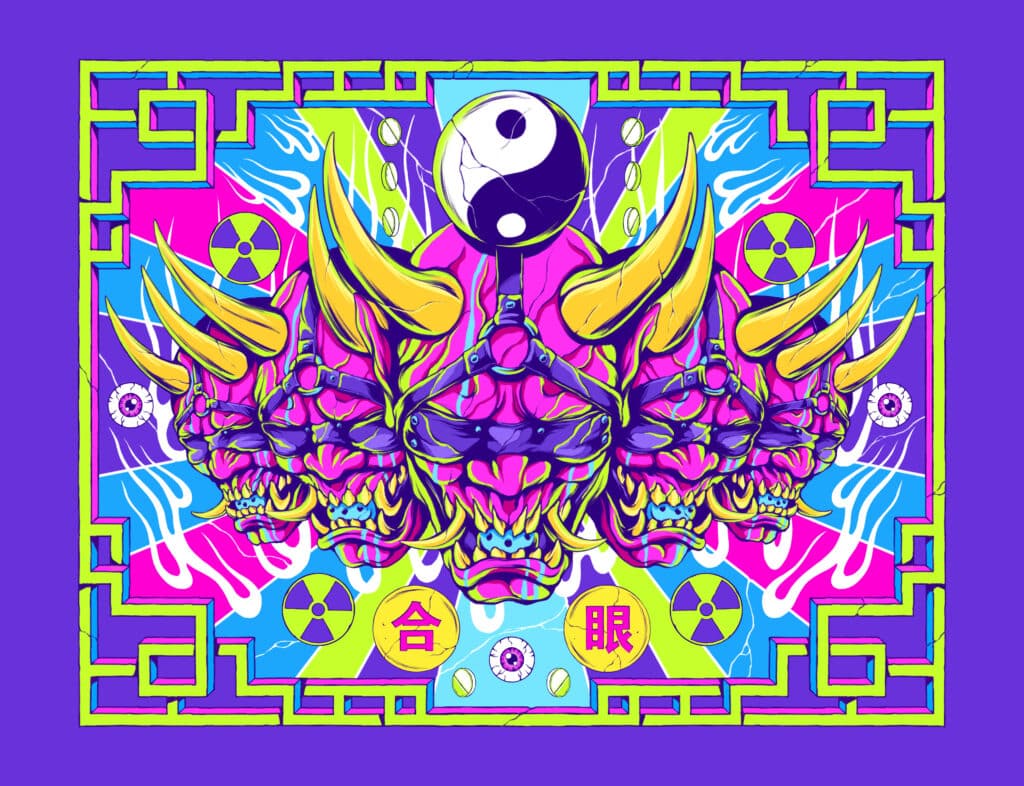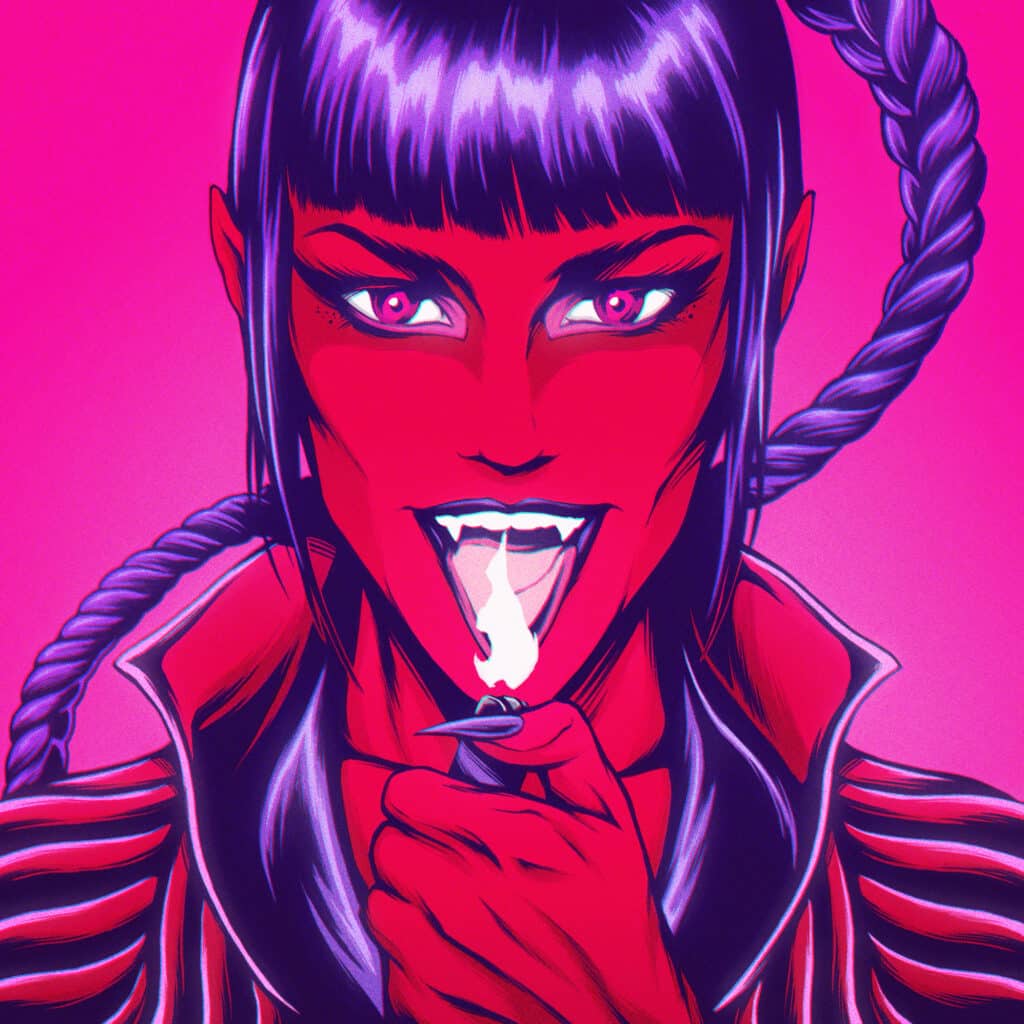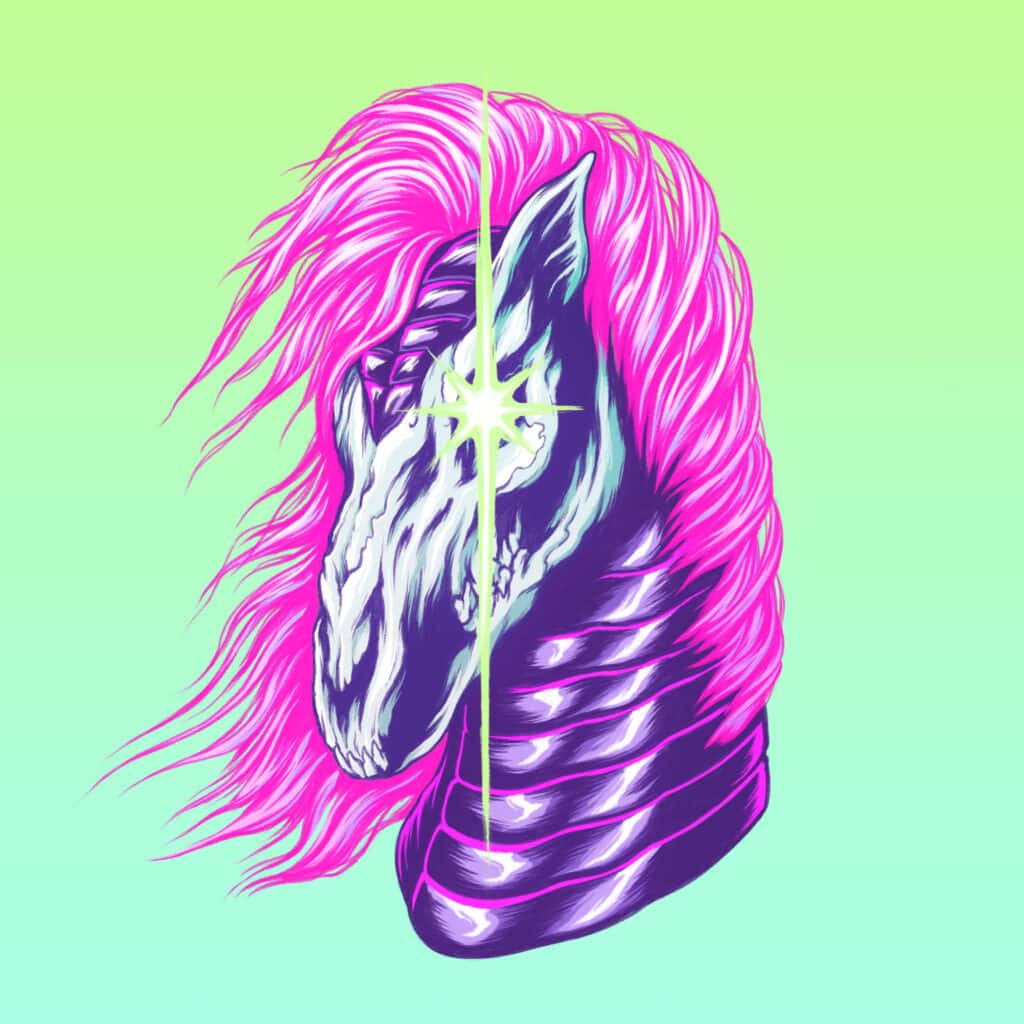James Jirat Patradoon creates a neon gothic paradise through mural, painting and animated gif art works which blend classical realism and Japanese anime with pop-horror. We spoke to the artist about his NFT experience. It seems for a digital artist who is wise to the gamification at play (and happy with the demystification of the art world) it has been a positive move, both financially and as a new creative frontier, for example he’s recently collaborated with singer Clara Fable to include sound loops in his animations.
Patradoon wishes he’d logged on sooner. Busy in the ‘real’ art world he was slow to take up the invite from his friend David Porte Beckefeld to join Foundation. Once the artist was online he felt gratified, ‘It just made so much sense for my work. I make everything digitally and have been doing short animation loops of my works but with no real platform to show them or sell them. I love making them but other than posting on Instagram they didn’t really have anywhere to go. The first couple of drops sold for more than the physical painted versions of them so that was very surreal.’
Buying and selling artworks verified by NFTs is a rapidly evolving digital realm, and clearly an interesting market for artists and investors. Or, as Patradoon suggests we can also see NFTs like trading cards. Presently, 1 Ether is worth approximately $3,300 AUD.

How did you decide what to showcase?
I only show my animations. Still images sell as NFTs as well but for me it’s important to sell something that could only inherently live online. A still image can be a print but an animating loop can’t really exist outside of a digital medium so I like how it’s tied to the medium in that way.
What are the pros and cons for an artist?
The pros would be opening your work up to a whole new market of collectors who aren’t conventional collectors and possibly make money off it. The cons would be putting a lot of work into something and having it go nowhere. It’s a strange new space and I have my own struggles with understanding why something sells and why another thing doesn’t. I’m lucky to be in a position where I have this backlog of work just sitting around on hard drives so it isn’t like I’m putting in all this work and expecting an outcome.
You can opt for auctions or static prices, which do you prefer and why?
I do both in the sense that I set I reserve, a minimum that I would be happy to sell the artwork for, and bids can go up from there. I’d be worried setting a really low reserve because these works take me forever to make so I’d hate something to go for something low, it’d feel like a real waste, but low reserves sometimes instigate the biggest bidding wars as well.

Can you explain if you cashed out from sales, or are you holding onto your crypto currency?
In the beginning when I was explaining a lot of NFT stuff to people they didn’t see why I wasn’t just going in and cashing out immediately and buying a new motorcycle or something. Covid forced me to become much more financially literate so I approach the crypto currency more like an investment, and that patience pays off when I see the price of Ethereum go up and down so much.
I don’t want to spend Ethereum on buying day to day stuff and end up like that guy back in the day who spent Bitcoin to buy pizza which would now be worth 613 Million etc. so mentally I try to forget that I have it and treat it more like my Superannuation or something, which I had to take out over Covid anyway.
How has it affected your practice?
The extra income has alleviated a lot of financial concerns, especially from covid. It’s changed my practice in that I can be more selective about what I spend my time on and the commercial illustration work I take on, as well as being able to focus on more personal work, which is all I want out of life to be honest.
It has also validated my animations and I want to make more of them. I’ve always wanted to do more but it always seemed like there was no real point to them because they’re so difficult to exhibit and literally make no money, but it’s a medium I really enjoy working in and now there is an outlet for it.
Has it made you rethink the traditional gallery model?
Having been an artist who is used to promoting my own stuff and leveraging my own social media for exhibitions anyway, this feels like just more of that direct approach and taking out the middle-man, but the new middle man is the platform that takes a commission, but unlike (or like) a gallery, they don’t do much by way of promoting you.
I do think there are aspects of the traditional gallery model that can work with NFTs. A gallery I’ve been working with for ages called Superchief Gallery in the US created the first ever NFT gallery space in Union Square New York which exhibits NFTs on flatscreens and projections and have their own NFT platform to sell the work from. It has been great exposure for the NFTs themselves and taking them outside of just being viewed on a laptop. I do believe in galleries’ importance when it comes to a space to view and experience art, I think people remember art when they’re physically experiencing it.
Do you have any particular feeling about people reselling the NFT?
Not at all, the best analogy I’ve found to understanding NFTs is to see them like trading cards.
People are trying to flip them and make money, or collect sets, or artists that they like, so in a lot of ways the collectors also have an interest in your value going up, it somewhat gamifies and demystifies art collecting, and the artists get a cut every time something is sold so it’s way fairer on the artist than say in the physical world.
Is the NFT system a good way to be protected from copyright infringement?
I never actually thought about it that way but that makes a lot of sense! I have also been hearing about people literally minting other people’s work and selling it so it’s a bit of a double-edged sword in that case.
Are you concerned about hacking or fraud?
Absolutely, I freak out about this constantly. Especially the surreal amount of money moving around so quickly it feels like it could all disappear in a puff of air or a computer glitch somewhere and this whole thing could be some kind of fever ‘Black Mirror-esque’ fantasy dream and I wake up and I’m broke again.

Do you think art will stay as an important part of the NFT realm, or will NFTs become the new normal for verifying documents or exchanges?
Yeah we’re definitely seeing NFTs move into more of that. It’s moving so quickly that it’s hard to say whether art will stay as a fundamental part of the NFT realm but I personally think it will, maybe not in the form that it is now where literally every first year design student who has done a Cinema 4D Youtube tutorial is trying to also cash in on it. It might whittle down both in terms of artists as well as collectors, but everyone is seeing it as this get rich quick scheme so probably not for a while.
What’s your advice for an artist looking to participate in this new field?
The advice I got was to go in with no expectations, but you also need to be serious about it and push your work on social media, which a lot of people still tend to underestimate.
I think the biggest misconception people have with this whole NFT thing is that they can just half-ass something, post it, and some idiot will buy it for thousands of dollars. I think if you go into anything with that lack of respect for the medium and the collectors then you won’t likely go far. It’s still money, collectors want to see a value in it and more importantly a value that grows, they’re not stupid.
I’m personally still confused by the whole thing as well, I can push something and push something and nothing sells. I think the market is stabilising now but we’re also still seeing artists sell for quite significant amounts.
I think just like in the physical world, a lot of it has to do with press and strategy, the market is absolutely saturated so you need to find ways your name is on top. Not everyone can discern what good or bad art is, it’s subjective after all, but if someone has your name up in lights and is telling the world you’re the one to collect then people will obviously gravitate toward that.
Check out Patradoon’s work for sale here on Foundation and follow his social media here.